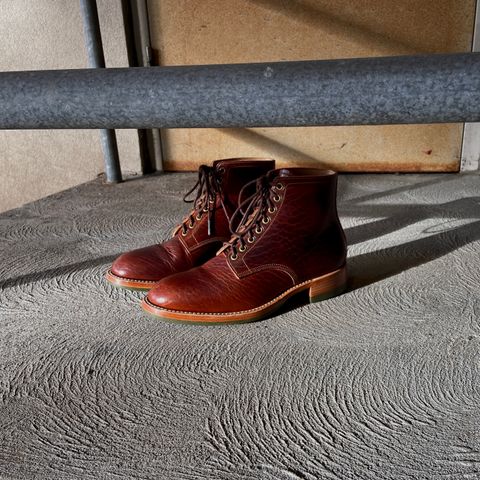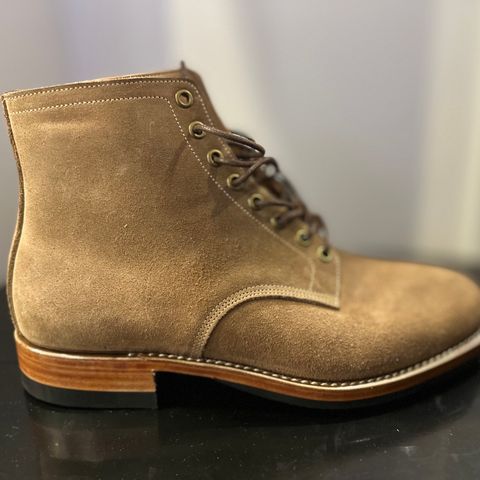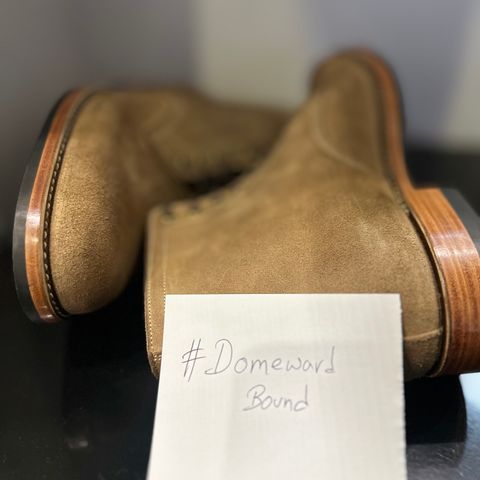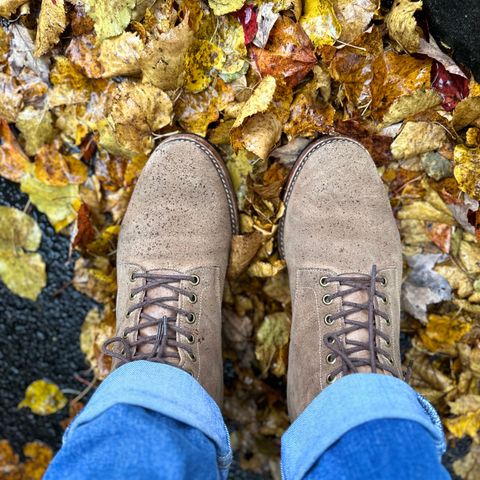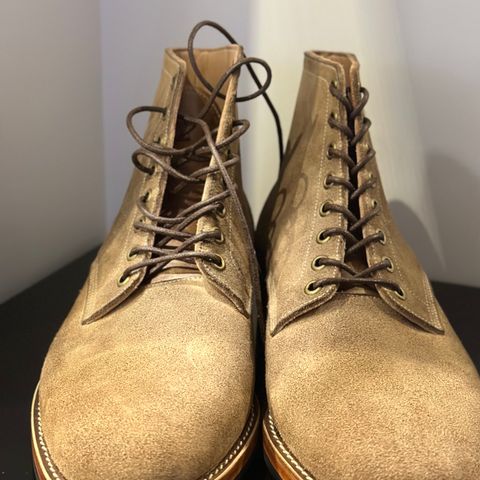About
The Onderhoud SPL02 is a distinctive split-toe boot model from Indonesian bootmaker Onderhoud Handmade, featuring traditional apron-front construction with the brand's signature hand-welted craftsmanship. This model represents Onderhoud's interpretation of the classic split-toe work boot design, combining heritage aesthetics with meticulous Indonesian craftsmanship at an accessible price point.
About
The Onderhoud SPL02 is a distinctive split-toe boot model from Indonesian bootmaker Onderhoud Handmade, featuring traditional apron-front construction with the brand's signature hand-welted craftsmanship. This model represents Onderhoud's interpretation of the classic split-toe work boot design, combining heritage aesthetics with meticulous Indonesian craftsmanship at an accessible price point.
The SPL02 showcases Onderhoud's commitment to traditional construction methods, with each pair entirely handcrafted by skilled artisans in the Bandung workshop. The split-toe design provides a distinctive visual profile while maintaining the functional durability expected from heritage work boots, making it a popular choice among customers seeking unique styling combined with exceptional build quality.
Design and Construction
Split-Toe Architecture
The SPL02 features the characteristic split-toe construction with an apron-front design that creates a distinctive visual separation at the toe cap. This construction method involves carefully stitching separate leather pieces to form the toe section, requiring precise pattern matching and skilled handwork to achieve proper alignment and aesthetic balance.
The apron construction extends from the toe cap up the vamp, creating visual interest while serving functional purposes by providing additional reinforcement in high-wear areas. The seam placement follows traditional split-toe patterns while incorporating Onderhoud's attention to detail in stitching precision and finishing quality.
Hand-Welted Construction
Like all Onderhoud boots, the SPL02 utilizes complete hand-welted construction, with every aspect of the bootmaking process completed by hand. The welt attachment, midsole stitching, and sole construction all demonstrate the careful handwork that distinguishes Onderhoud from machine-manufactured alternatives.
The hand-stitching quality on the SPL02 is particularly evident in the deliberate diagonal angles of the midsole stitching, which emphasize the human craftsmanship involved in each pair. These intentional variations in stitch angle serve as signatures of the handmade construction process while ensuring structural integrity.
Materials and Options
Leather Selections
The SPL02 is available in various leather options that align with Onderhoud's material preferences, with horsebutt leather being a frequently selected option. Premium leather choices include natural Chromexcel from Horween Leather Company and vegetable-tanned horsebutt from select European tanneries.
Horsebutt leather provides exceptional durability and unique aging characteristics, developing rich patina and texture variations through wear. The dense fiber structure of horsebutt makes it particularly suitable for the split-toe construction, where leather strength and moldability are essential for achieving proper shape retention.
Hardware and Components
The SPL02 incorporates quality hardware components selected for durability and aesthetic compatibility with the split-toe design. Eyelets and speed hooks are chosen to complement the leather selection while providing functional lacing performance for daily wear applications.
Internal components include cork footbeds for cushioning and moisture absorption, with leather midsoles providing flexibility appropriate for the hand-welted construction method. These materials work together to create comfortable wear characteristics while maintaining the structural integrity expected from traditional construction.
Fit and Sizing
Last Characteristics
The SPL02 is constructed using Onderhoud's standard last configuration, which provides accommodation for various foot shapes while maintaining the model's distinctive split-toe silhouette. The last offers substantial toe room appropriate for the apron-front construction while balancing comfort with proportional aesthetics.
Customers typically find the SPL02 fits consistently with other Onderhoud models, though the split-toe construction may influence fit characteristics slightly compared to plain-toe alternatives. The handmade construction process contributes to fit consistency while allowing for the slight variations inherent in hand-lasted boots.
Break-In Considerations
Break-in requirements for the SPL02 vary based on leather selection and individual foot characteristics, with most customers reporting comfortable fit after an initial adjustment period. The split-toe construction may require slightly different break-in patterns compared to traditional toe designs, as the apron seams adjust to foot movement over time.
The hand-welted construction contributes to gradual comfort improvement as the cork footbed molds to the wearer's foot shape and the leather upper develops appropriate flexibility patterns.
Production and Availability
Manufacturing Process
Each SPL02 is produced in Onderhoud's small Bandung workshop, where the brand maintains a philosophy of limited production focusing on quality over quantity. The split-toe construction requires additional time and skill compared to plain-toe models, as the pattern cutting and seam matching demand precise handwork to achieve quality results.
The extended production timeline reflects both the complexity of split-toe construction and Onderhoud's commitment to quality over quantity. Each pair receives individual attention throughout the construction process, ensuring that both structural and aesthetic standards are met before completion.
Ordering and Pricing
The SPL02 follows Onderhoud's standard ordering process through Instagram communication with founder Rizky Afnan, who personally manages customer relationships and order coordination. The lottery system for order acceptance applies to all models, including the SPL02, due to the limited production capacity.
Pricing for the SPL02 varies based on leather selection and customization options, with costs reflecting the handmade construction and premium materials used. The split-toe construction may influence pricing due to the additional complexity required in pattern development and assembly compared to simpler toe designs.
Cultural Significance
Heritage and Tradition
The SPL02 represents Onderhoud's interpretation of traditional split-toe work boot design, adapting American and European heritage patterns to Indonesian craftsmanship techniques. This cultural fusion demonstrates how traditional bootmaking methods can be preserved and adapted across different cultural contexts while maintaining authentic construction standards.
The model contributes to Onderhoud's mission of preserving hand-welted construction techniques while proving that exceptional craftsmanship can emerge from unexpected geographic locations in the global footwear industry.
Market Impact
The SPL02's success has helped establish Onderhoud's reputation for producing distinctive boot styles that differentiate the brand from other heritage bootmakers. The split-toe design offers customers unique aesthetic options while maintaining the quality and value proposition that characterizes all Onderhoud products.
The model demonstrates that small-scale production can compete effectively with larger manufacturers by focusing on specialized designs and superior craftsmanship rather than production volume or marketing scale.
Maintenance and Longevity
Care Requirements
Proper maintenance of the SPL02 focuses on preserving both the structural integrity and aesthetic appearance of the split-toe construction. Regular conditioning maintains leather flexibility while protecting the multiple seam lines that characterize the apron-front design.
The split-toe construction requires attention to seam areas where different leather pieces meet, as these locations may experience different wear patterns and require specific care considerations to maintain appearance over time.
Repair and Resoling
The hand-welted construction enables professional resoling when the outsole reaches the end of its useful life, significantly extending the SPL02's lifespan. The split-toe design does not complicate resoling procedures, as the upper construction remains intact during sole replacement operations.
Quality cobbler services familiar with hand-welted construction can maintain the SPL02 effectively, though finding craftspeople experienced with split-toe aesthetics may be beneficial for maintaining the model's distinctive appearance through repair cycles.
References
"Onderhoud Handmade Instagram". Official brand social media account. Retrieved September 18, 2025.
"Traditional Boot Construction Methods". Footwear News. March 2023. Retrieved September 18, 2025.
"Hand-Welted vs Machine Construction in Heritage Boots". Leatherworkers Corner. May 2022. Retrieved September 18, 2025.
"Split-Toe Boot Design History and Construction". Boot Craftsmen Guild. January 2024. Retrieved September 18, 2025.
Wilson, James. "Indonesian Craftsmanship in Heritage Footwear". Permanent Style. September 2018. Retrieved September 18, 2025.
